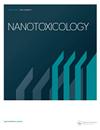粒径效应和黏液对E551食品添加剂和工程二氧化硅纳米颗粒肠道毒性的影响
IF 3.4
3区 医学
Q3 NANOSCIENCE & NANOTECHNOLOGY
引用次数: 4
摘要
摘要E551食品添加剂是由人工合成的无定形二氧化硅颗粒组成。目前的法规没有提到任何关于它们的大小和颗粒分布的规格,因此允许存在二氧化硅纳米颗粒,尽管它们具有潜在的毒性。消化过程可以改变它们的理化性质,进而影响它们的毒理学特征。在体外肠屏障模型中,对20 ~ 200 nm的工程二氧化硅纳米颗粒、天然和消化的E551添加剂的亚急性毒性进行了理化表征。建立了肠细胞和粘液分泌细胞的单培养和共培养来研究粘液的作用。毒理学终点包括细胞毒性、活性氧产生、肠通透性增加和肌动蛋白丝断裂。结果显示,二氧化硅纳米颗粒对细胞毒性和肠道通透性具有大小依赖性。在Caco-2细胞中观察到肌动蛋白丝的时间依赖性断裂。在HT29-MTX单培养物上扩散的黏液层作为有效的保护屏障,而在共培养物中,小的纳米颗粒能够穿过它到达细胞。从70 nm的流体动力学直径来看,纳米颗粒在肠细胞中没有内化,即使在无黏液模型中也是如此。消化对添加剂的理化性质没有影响。由于平均水动力直径接近200 nm,天然和消化的E551添加剂在肠道屏障模型中均未引起任何毒性作用。本研究强调,E551添加剂与肠细胞的相互作用将受到限制的截止尺寸为70 nm。本文章由计算机程序翻译,如有差异,请以英文原文为准。
Size effect and mucus role on the intestinal toxicity of the E551 food additive and engineered silica nanoparticles
Abstract The E551 food additive is composed of synthetic amorphous silica particles. The current regulation does not mention any specifications regarding their size and granulometric distribution, thus allowing the presence of silica nanoparticles despite their potential toxicity. The digestion process could modify their physicochemical properties and then influence their toxicological profile. After physicochemical characterization, subacute toxicity of engineered silica nanoparticles from 20 to 200 nm, native and digested E551 additives were evaluated from in vitro models of the intestinal barrier. Single cultures and a co-culture of enterocytes and mucus-secreting cells were established to investigate the mucus role. Toxicological endpoints including cytotoxicity, ROS production, intestinal permeability increase, and actin filament disruption were addressed after a 7-day exposure. The results showed a size-dependent effect of silica nanoparticles on cytotoxicity and intestinal permeability. A time-dependent disruption of actin filaments was observed in Caco-2 cells. The mucus layer spread on the HT29-MTX single culture acted as an efficient protective barrier while in the co-culture, small nanoparticles were able to cross it to reach the cells. From a hydrodynamic diameter of 70 nm, nanoparticles were not internalized in the intestinal cells, even in mucus-free models. Digestion did not affect the physicochemical properties of the additive. Due to a mean hydrodynamic diameter close to 200 nm, both native and digested E551 additives did not induce any toxic effect in intestinal barrier models. This study emphasized a cutoff size of 70 nm from which the interactions of the E551 additive with intestinal cells would be limited.
求助全文
通过发布文献求助,成功后即可免费获取论文全文。
去求助
来源期刊

Nanotoxicology
医学-毒理学
CiteScore
10.10
自引率
4.00%
发文量
45
审稿时长
3.5 months
期刊介绍:
Nanotoxicology invites contributions addressing research relating to the potential for human and environmental exposure, hazard and risk associated with the use and development of nano-structured materials. In this context, the term nano-structured materials has a broad definition, including ‘materials with at least one dimension in the nanometer size range’. These nanomaterials range from nanoparticles and nanomedicines, to nano-surfaces of larger materials and composite materials. The range of nanomaterials in use and under development is extremely diverse, so this journal includes a range of materials generated for purposeful delivery into the body (food, medicines, diagnostics and prosthetics), to consumer products (e.g. paints, cosmetics, electronics and clothing), and particles designed for environmental applications (e.g. remediation). It is the nano-size range if these materials which unifies them and defines the scope of Nanotoxicology .
While the term ‘toxicology’ indicates risk, the journal Nanotoxicology also aims to encompass studies that enhance safety during the production, use and disposal of nanomaterials. Well-controlled studies demonstrating a lack of exposure, hazard or risk associated with nanomaterials, or studies aiming to improve biocompatibility are welcomed and encouraged, as such studies will lead to an advancement of nanotechnology. Furthermore, many nanoparticles are developed with the intention to improve human health (e.g. antimicrobial agents), and again, such articles are encouraged. In order to promote quality, Nanotoxicology will prioritise publications that have demonstrated characterisation of the nanomaterials investigated.
 求助内容:
求助内容: 应助结果提醒方式:
应助结果提醒方式:


